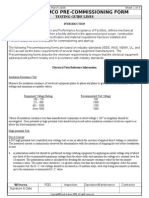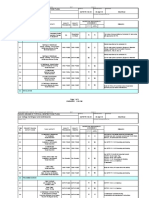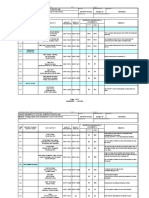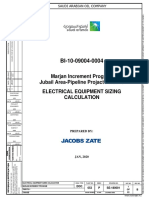Wiring Methods and Materials: Summary of SAES-P-104
Wiring Methods and Materials: Summary of SAES-P-104
Uploaded by
Afzal AsifCopyright:
Available Formats
Wiring Methods and Materials: Summary of SAES-P-104
Wiring Methods and Materials: Summary of SAES-P-104
Uploaded by
Afzal AsifOriginal Description:
Original Title
Copyright
Available Formats
Share this document
Did you find this document useful?
Is this content inappropriate?
Copyright:
Available Formats
Wiring Methods and Materials: Summary of SAES-P-104
Wiring Methods and Materials: Summary of SAES-P-104
Uploaded by
Afzal AsifCopyright:
Available Formats
WIRING METHODS AND MATERIALS
Summary of SAES-P-104
MOHAMMED AFZAL ASIF
CONTRACTING AND TRADING COMPANY “C.A.T.”
JANUARY 21, 2020
This standard prescribes mandatory requirements for the design and installation of insulated power and control wiring (between electrical control and
monitoring devices) cable systems and minimum mandatory requirements for their outdoor enclosure. Please note, it doesn’t apply to internal wiring of
equipment and overhead distribution systems. In case of any conflict with this standard SAES-P-104 shall take precedence or should be addressed to the
EK&RD Coordinator.
For this standard only, Outdoor corresponds to wet or damp locations
Indoor corresponds to dry locations unless it contradicts with NEC
WIRE AND CABLE:
Copper (preferred) or Aluminium (only in community areas for sizes 25mm2 or larger) conductors.
Each power circuit should be grounded as mandated in SAES-P-111.
POWER AND CONTROL CABLES
Low Voltage Medium Voltage High Voltage
Jacketed Unjacketed
15-SAMSS-502 or 15-SAMSS- AEIC CS6 or CS9 or 15-
IEC 60227 or
Comply With NEC IEC 60502-1 NEC 503 (in case of submarine SAMSS-504 (in case of
SASO 55
power cables) submarine power cables)
Voltage Rating 600V 600/1000V 600V 450/750V 5kV through 35kV 69kV and above
Minimum Temp. 90°C (dry) / 90°C (dry) /
85°C 85°C
Rating 75°C (wet) 75°C (wet)
Flame test of Flame test of
Conform to UL Standards UL Standards
IEC 60332-3 IEC 60332-1
Suitable to use in Class 1, Division 2 and Zone 2 Class 1, Division 2 and Zone 2
Shall not be used in cable trays
Specific
duct banks involving manholes,
Requirement
or direct burial applications.
Minimum Size: Maximum Size:
Conductors rated below 69 kV shall be 500 mm² or 1,000 kcmils.
Size of
Conductors
Individual control wires shall be identified by two labels at each end. One to identify the connected terminal and the other to
identify the terminal on the opposite end.
Individual phases shall be color-coded (as per SASO) or marked by other means like A, B and C, Neutral conductor should be
Identification
white/grey and grounding conductor should be green with yellow stripes.
Wrap-around, rigid snap-on, or adhesive type markers are not permitted for wire or cable identification.
Voltage stress relief shall be provided at terminations of cables with insulation shields.
Tinned copper compression (crimped) type connectors shall be used.
(a) For lighting and receptacle circuits in non-hazardous locations, and (b) in non-industrial applications spring pressure type
twist-on connectors, and pressure set screw connectors with insulating caps are permitted.
If a different type of connector is an integral part of an equipment then it is permitted.
Connections and Insulated ring tongue, locking fork tongue, flanged fork tongue and pin type compression (crimped) terminals shall be used for
Terminations control wiring.
Compression terminal connectors for 4/0 and larger conductors shall be two hole design.
All compression connectors for 8 AWG and larger conductors shall have a manufacturer's reference compression die number and
conductor size printed or stamped on the connector.
Cable glands shall be designed to permit disconnection without the need to rotate the cable or the equipment on which the
gland is terminating.
There are no minimum separation requirements between power and/or control conductors for DC or AC circuit voltages
less than 1,000 V, provided the insulation is rated at least 600 V or 450/750 V.
Minimum separation (above or below ground) between a power cable operating at 1000 V or above, up to 34.5 kV, and
Cable a parallel or crossing power or control cable operating at less than 1,000 V, shall be 300 mm.
Separation Redundant feeders, direct buried or in direct buried conduits, supplying industrial loads or other loads that are critical in
accordance with SAES-P-100, shall be separated by a minimum distance of 1.8 meters.
Minimum separation (above or below ground) between any cable operating at above 34.5 kV, and cables operating at or
below 34.5 kV, shall be 1 m.
Power and control conductors shall be stranded in accordance with ASTM B8 Class B or C, or ASTM B496, or IEC 60228 Class 2
Splicing of conductors shall be kept to a minimum. In case of accidental damage, one additional splice than the maximum is
permitted.
Armored cable shall be used for underground installations. Un-armored type cables shall be used for cable tray (TC type) and
conduit systems installations.
Cables for security lighting (perimeter and area lighting) shall be armored or metal clad, installed underground, and rising inside
General the lighting poles.
Specifications Metal clad cable and armored cable shall be permitted to be installed and exposed where it is not subject to damage by
vehicular traffic or similar hazards but that exposed section shall be supported at intervals not exceeding 1.8 meters. Other types
of cable shall not be installed or exposed above ground, and shall be installed in cable trays, conduit, or where flexibility is
required in flexible conduit.
Conductors of multi-conductor control cables shall be numbered or color-coded by colors other than green, green with yellow
stripes, white or grey.
Fireproofing of cables shall be in accordance with SAES-B-006 (onshore facilities) or SAES-B-009 (offshore facilities).
ENCLOSURES
For plant areas/process Shall be (a) NEMA 250/NEMA ICS 6 Type 4 or (b) NEMA Type 3 manufactured copper free cast aluminium (0.4 of 1%
unit outdoor maximum), or plastic (including fiberglass); or (c) IEC 60529 Type IP54 or better.
Shall be (a) NEMA Type 4X (except galvanized and/or painted or coated carbon steel sheet metal enclosures are not
For severe corrosive permitted); or (b) NEMA Type 3 or 4, manufactured of copper free cast aluminium (0.4 of 1% copper maximum), or
environments outdoor plastic (including fiberglass); or (c) IEC 60529 Type IP54 or better, manufactured of stainless steel (Type 304 or better),
copper free cast aluminium, or plastic (including fiberglass).
For dry-type
NEMA Type 3R
transformers outdoor
CONDUITS
Underground Exposed Outdoor Exposed in severe corrosive environment
Directly buried conduit shall be
PVC Type DB-120 or EPC-40.
Shall be threaded and hot-dip Shall be threaded, hot-dip galvanized and factory PVC
Types Used Concrete encased conduit shall
galvanized. coated (min 1mm thick)
be PVC Type EB-35 or DB-120 or
EPC-40.
Shall be cast or forged steel, Same as normal outdoor fittings but in addition, shall
Similar to fittings of conduits cast iron or malleable iron, be protected by (a) Factory-coating with PVC or (b)
Conduit Fittings exposed in severe corrosive either hot-dip galvanized Field-coating prior to installation in accordance with
environment. (preferably), or zinc SAES-H-001 APCS-22 (offshore), or APCS-26 (onshore)
electroplated or (c) Heat-shrinkable tubes or wrap-around.
Similar to normal support but in addition, shall be
Shall be made of steel or iron, either hot-dip galvanized (preferably),
Supports protected by (a) means used to protect other fittings
or zinc electroplated
or (b) stainless steel or (c) fiberglass.
Size of conduits Minimum ¾ inch. For instrumentation wiring, prefabricated skids, and in non-industrial areas it shall be ½ inch.
CABLE TRAYS
Indoor Outdoor
Copper-free aluminium or galvanized steel carbon (in
Copper-free aluminium (in accordance with NEMA VE 1 and
Material Used accordance with NEMA VE 1 and VE 2) or fiberglass (in
VE 2) or fiberglass (in accordance with NEMA FG 1).
accordance with NEMA FG 1).
Type Used Ladder (two side-rail) type
Rung Load Capacity Minimum individual rung load capacity = 90kgs
Working load = weight of cables + future addition (if required) + concentrated static load of 90 kg at the centre of the span. It
Maximum Working
shall not exceed the rated load capacity of the cable tray defined in NEMA VE 1 or NEMA FG 1 and the deflection of cable
Load Capacity
tray system shall not exceed L/100 (L=span length) when loaded to working load (excluding concentrated static load).
Only flanged type ventilated covers shall be used and secured with stainless steel banding (one band per ½ m of cover length,
Covers with a minimum of six bands per cover) and fasteners. Cable trays that run vertically in outdoor areas shall have covers on
both sides.
UNDERGROUND CABLE SYSTEMS
But In areas where digging must be minimized, cables may be
installed in one of the following configurations:
PVC coated rigid steel conduit with a total cover not less than
300 mm or 150mm, which shall include a 50 mm or 100mm
respectively thick (minimum) reinforced concrete slab over the
Minimum depth of burial
conduit; or
A reinforced concrete encased duct bank with 150 mm of total
cover, measured from the top of the upper conduit, which
shall include a minimum of 100 mm of concrete over the
upper conduit
Shall consist of PVC conduit encased in unreinforced concrete (for no traffic, or occasional traffic areas) or reinforced
concrete (for frequent traffic areas).
Shall consist of steel conduit encased in unreinforced concrete.
There shall be a minimum of 75 mm of concrete from the outside surface of the duct bank to any conduit or
Duct Banks
reinforcing steel. Fabricated spacers shall be used at intervals not exceeding 2.4 meters. The spacers shall provide a
minimum conduit separation of 50 mm for 2 inch conduits and larger, and 25 mm for 1½ inch conduits and smaller.
The top layer (5 mm minimum thickness) of the concrete shall be mixed with red dye.
Duct banks shall have 20% spare ducts (minimum of one), unless this number is decreased by the facility Proponent.
SUBMARINE POWER CABLE
For water depth less than 7.5 m measured at the Lowest Astronomical Tide (LAT), submarine cable shall be buried a minimum of 1 m.
In areas within 100 m of a platform structure, submarine cable shall be (a) buried a minimum of 1 m, (b) protected with grout-filled bags, (c) by a split
tubing protection system, or (d) similar protection method.
The axial spacing between separate circuits of the land section shall be minimum of 4.5 m. The axial spacing between cables in the submarine section,
excluding that portion of the cable within 200 m of the platform, shall be equal to the mean water depth.
Submarine cable shall be physically protected from the bottom of the jacket leg to the point of cable armor termination, by a trough, tube or direct
mounting to the jacket leg. Cables shall not hang unprotected.
You might also like
- List of Electrical Aramco StandardDocument1 pageList of Electrical Aramco StandardUzair Ahmad100% (3)
- QC E & I - Questions & AnswersDocument45 pagesQC E & I - Questions & Answerssab jee86% (7)
- Saudi Aramco Engineering Standard For ElectricalDocument3 pagesSaudi Aramco Engineering Standard For Electricalmanaf vt100% (1)
- QC Notes For Intruments AramcoDocument4 pagesQC Notes For Intruments AramcoManda Khel Apna Des100% (1)
- Aramco Questions For Electrical InstrumentationDocument6 pagesAramco Questions For Electrical Instrumentationssmith2007100% (2)
- Materials System SpecificationDocument14 pagesMaterials System Specificationnadeem shaikh100% (3)
- Saudi Aramco Test Report: SATR-P-3210 3-Jul-18 Elect-Medium Voltage Power Cable, High-Potential Withstand TestingDocument10 pagesSaudi Aramco Test Report: SATR-P-3210 3-Jul-18 Elect-Medium Voltage Power Cable, High-Potential Withstand Testingkarthi51289No ratings yet
- T80-ZA-E-2204072 - Installation of Cable Tray, PDFDocument19 pagesT80-ZA-E-2204072 - Installation of Cable Tray, PDFNezinNo ratings yet
- ARAMCO QC Question InstrumentationDocument32 pagesARAMCO QC Question InstrumentationMani Kanta100% (2)
- Nfpa 70 905 Questions and AnswersDocument311 pagesNfpa 70 905 Questions and AnswersTerry XuNo ratings yet
- Saudi Aramco Test ReportDocument6 pagesSaudi Aramco Test Reportkarthi51289No ratings yet
- Saudi Aramco Pre-Commissioning Form: Low Voltage CablesDocument2 pagesSaudi Aramco Pre-Commissioning Form: Low Voltage CablesHaleem Ur Rashid BangashNo ratings yet
- SAES-P-101 Vendors List For Electrical EquipmentDocument9 pagesSAES-P-101 Vendors List For Electrical EquipmentfaisalqrNo ratings yet
- Saudi Aramco Inspection Checklist (SAIC) Title: ElectricalDocument11 pagesSaudi Aramco Inspection Checklist (SAIC) Title: ElectricalBhaskar Pitchika100% (1)
- Saes P 101Document9 pagesSaes P 101nuriaNo ratings yet
- Saudi Aramco Pre-Commissioning Form: Low Voltage Power Circuit BreakersDocument3 pagesSaudi Aramco Pre-Commissioning Form: Low Voltage Power Circuit BreakersHaleem Ur Rashid Bangash100% (1)
- Typical Inspection Plan (TIP) Title: ElectricalDocument2 pagesTypical Inspection Plan (TIP) Title: ElectricalBhaskar Pitchika100% (1)
- 14 Samss 533 PDFDocument14 pages14 Samss 533 PDFMudabbir HussainNo ratings yet
- Electrical Questions 2Document8 pagesElectrical Questions 2chandu666creatorNo ratings yet
- Sa P 041Document5 pagesSa P 041Haleem Ur Rashid BangashNo ratings yet
- Summary of SAES-J-902Document7 pagesSummary of SAES-J-902Afzal Asif100% (1)
- Summary of SAES-P-111Document5 pagesSummary of SAES-P-111Afzal Asif100% (2)
- Answers To QC QuestionDocument37 pagesAnswers To QC QuestionDot PidotNo ratings yet
- Saes P 121Document18 pagesSaes P 121wastazoheb_700349353No ratings yet
- Saudi Aramco Test ReportDocument7 pagesSaudi Aramco Test Reportkarthi51289No ratings yet
- 16 Samss 520Document11 pages16 Samss 520HatemS.MashaGbehNo ratings yet
- Saudi Aramco Inspection Checklist: SAIC-P-3333 Elect-Ductbank / Conduit Excavation, Trenching and BackfillingDocument6 pagesSaudi Aramco Inspection Checklist: SAIC-P-3333 Elect-Ductbank / Conduit Excavation, Trenching and Backfillingmkalidas2006No ratings yet
- 15 Samss 502Document10 pages15 Samss 502Praba Hiruthya SNo ratings yet
- Saudi Aramco Pre-Commissioning Form: Testing Guide LinesDocument4 pagesSaudi Aramco Pre-Commissioning Form: Testing Guide LinesHaleem Ur Rashid Bangash100% (1)
- Satip P 121 01 Rev 7 MPDocument7 pagesSatip P 121 01 Rev 7 MPmohamedqcNo ratings yet
- 34 Samss 913Document22 pages34 Samss 913naruto256No ratings yet
- Cable Tray Installation Procedure - PaktechpointDocument7 pagesCable Tray Installation Procedure - Paktechpointmiong puuzzNo ratings yet
- QC Qustion and AnswerDocument32 pagesQC Qustion and Answerrajum465100% (2)
- QMISDocument14 pagesQMISLopez Gardo50% (2)
- Saudi Aramco Test ReportDocument11 pagesSaudi Aramco Test Reportkarthi51289100% (1)
- Saes T 911Document60 pagesSaes T 911RijoNo ratings yet
- SATIP-P-116-03 Rev 7 FinalDocument4 pagesSATIP-P-116-03 Rev 7 FinalHatemS.MashaGbehNo ratings yet
- 34-SAMSS-913 Instrumentation and Thermocouple CableDocument21 pages34-SAMSS-913 Instrumentation and Thermocouple CablenavaronefraNo ratings yet
- SAIC-P-3701 Rev 0Document3 pagesSAIC-P-3701 Rev 0mkalidas2006No ratings yet
- Saic J 6001Document7 pagesSaic J 6001sureshNo ratings yet
- E&i QC Inspector Resum and DocumentsDocument24 pagesE&i QC Inspector Resum and DocumentsIrfan 786pak100% (1)
- Qa-Qc E&i Inspection NotesDocument57 pagesQa-Qc E&i Inspection NotesRain OrshineNo ratings yet
- 16 Samss 521Document8 pages16 Samss 521Eagle SpiritNo ratings yet
- SAIC-P-3007 Rev 7 FinalDocument20 pagesSAIC-P-3007 Rev 7 FinalEnginerShahzadGhaffar100% (1)
- SATIP-P-104-02 Rev 7 FinalDocument3 pagesSATIP-P-104-02 Rev 7 FinalHatemS.MashaGbehNo ratings yet
- SATIP-P-104-05 Rev 8 Final Above Grade Conduits PDFDocument2 pagesSATIP-P-104-05 Rev 8 Final Above Grade Conduits PDFSabheeh AliNo ratings yet
- E & I Construction SuperintendentDocument8 pagesE & I Construction SuperintendentMohammad SaifullahNo ratings yet
- What Is: Electrical QuestionaireDocument19 pagesWhat Is: Electrical QuestionaireDanish H100% (10)
- QC Question Answer Manifa MadenDocument34 pagesQC Question Answer Manifa Madenvenkatesh100% (1)
- Specification For Instrument CablesDocument12 pagesSpecification For Instrument Cablesprabha haranNo ratings yet
- Second List of Non Inspectable Materials For Sa Approval - Vid RemarksDocument6 pagesSecond List of Non Inspectable Materials For Sa Approval - Vid RemarksMohamed Reda100% (2)
- 3.2 Method Statement For Cable Pulling and TerminationDocument12 pages3.2 Method Statement For Cable Pulling and TerminationAravind DasanNo ratings yet
- Interview Questions For Electrical & CPDocument169 pagesInterview Questions For Electrical & CParyambp125No ratings yet
- E&i Method Statement ListDocument3 pagesE&i Method Statement ListAfzal AsifNo ratings yet
- Saes P 119Document17 pagesSaes P 119drbabithameringeorgemdsorthoNo ratings yet
- Instrument QC Inspectors Test Question AnswersDocument8 pagesInstrument QC Inspectors Test Question Answerszhangyili50% (2)
- MOS For Metallic Conduit InstallationDocument23 pagesMOS For Metallic Conduit InstallationAhmed MhnaNo ratings yet
- 26 05 20 - Cables For InstrumentationDocument5 pages26 05 20 - Cables For InstrumentationAmar SheteNo ratings yet
- Katko Switches Technical Information AllDocument10 pagesKatko Switches Technical Information AllSanishka NiroshanNo ratings yet
- Texas AM MV SpecificationDocument11 pagesTexas AM MV SpecificationDavid BurgessNo ratings yet
- BI-10-09004-0004 Marjan Increment Program Jubail Area-Pipeline Projact PKG#18 LV Cable Sizing CalculationDocument7 pagesBI-10-09004-0004 Marjan Increment Program Jubail Area-Pipeline Projact PKG#18 LV Cable Sizing CalculationAfzal AsifNo ratings yet
- MSD Legend: CS, 1.6 MM CA, VT-8 CS: Carbon Steel Ca: Corrosion Allowance VT: Valve TrimDocument1 pageMSD Legend: CS, 1.6 MM CA, VT-8 CS: Carbon Steel Ca: Corrosion Allowance VT: Valve TrimAfzal AsifNo ratings yet
- Marjan Increment Program Jubail Area-Pipeline Projact PKG#18 Electrical Equipment Sizing CalculationDocument22 pagesMarjan Increment Program Jubail Area-Pipeline Projact PKG#18 Electrical Equipment Sizing CalculationAfzal AsifNo ratings yet
- BI-10-09004-0004 Marjan Increment Program Jubail Area-Pipeline Projact PKG#18 DC System Sizing CalculationDocument32 pagesBI-10-09004-0004 Marjan Increment Program Jubail Area-Pipeline Projact PKG#18 DC System Sizing CalculationAfzal AsifNo ratings yet
- Saudi Arabian Oil Company: MSD LegendDocument1 pageSaudi Arabian Oil Company: MSD LegendAfzal AsifNo ratings yet
- CS, 0.0 MM Ca CS, 0.0 MM Ca: 657-D-0002 Tnjbeth-1 Pipeline 657-D-0001Document1 pageCS, 0.0 MM Ca CS, 0.0 MM Ca: 657-D-0002 Tnjbeth-1 Pipeline 657-D-0001Afzal AsifNo ratings yet
- Coating Selection Plan "Map"Document2 pagesCoating Selection Plan "Map"Afzal AsifNo ratings yet
- E&i Method Statement ListDocument3 pagesE&i Method Statement ListAfzal AsifNo ratings yet
- SAEP-88 Appendix J: Materials Selection Table (MST) Template (1 of 2)Document2 pagesSAEP-88 Appendix J: Materials Selection Table (MST) Template (1 of 2)Afzal AsifNo ratings yet
- Field InstrumentsDocument27 pagesField InstrumentsAfzal AsifNo ratings yet
- DCS, ESD Comment Sheet - SachinDocument3 pagesDCS, ESD Comment Sheet - SachinAfzal AsifNo ratings yet
- Malik Alotaibi ResearchDocument15 pagesMalik Alotaibi ResearchAfzal AsifNo ratings yet
- 4 - Tom Jansen - Multilayer Design Approach For The Utilization of High Volumes of Off Spec Coal Combustion Products in Transportation InfrastructureDocument35 pages4 - Tom Jansen - Multilayer Design Approach For The Utilization of High Volumes of Off Spec Coal Combustion Products in Transportation InfrastructureIwan SusantoNo ratings yet
- Method of Making 6-EthoxyquinolineDocument2 pagesMethod of Making 6-EthoxyquinolineMichal SlavíčekNo ratings yet
- Quick Reference-Fire Fighting (Part-1) : Class Type of Fire Type of Fire ExtinguisherDocument17 pagesQuick Reference-Fire Fighting (Part-1) : Class Type of Fire Type of Fire ExtinguisherYamral WubetuNo ratings yet
- Size LubrificationDocument12 pagesSize LubrificationfernandolimaNo ratings yet
- SkagaCollection 2013Document112 pagesSkagaCollection 2013Fabian DeeNo ratings yet
- TenCate Polyfelt TS 5m TechnicalData EN 502102Document1 pageTenCate Polyfelt TS 5m TechnicalData EN 502102Sebastián A. Sáez GonzálezNo ratings yet
- Tle6-Ia-Las-3a TestDocument5 pagesTle6-Ia-Las-3a TestjeanNo ratings yet
- Specification For Seamless Red Brass Pipe, Standard SizesDocument8 pagesSpecification For Seamless Red Brass Pipe, Standard SizesVCNo ratings yet
- Sewn Board BindingsDocument18 pagesSewn Board BindingsAlejandra MillanNo ratings yet
- The Inner Transition Elements (F-Block)Document10 pagesThe Inner Transition Elements (F-Block)Kamalini.RNo ratings yet
- Field Applied Coating of Corrugated Metal Structural Plate For Pipe, Pipe-Arches, and ArchesDocument2 pagesField Applied Coating of Corrugated Metal Structural Plate For Pipe, Pipe-Arches, and ArchesFRANZ RICHARD SARDINAS MALLCONo ratings yet
- Line Filter CatalogueDocument2 pagesLine Filter CatalogueJunaid AhmedNo ratings yet
- Labour Cost Estimate and Material Estimate For 2bed and 1bedroom Flat 6flat Building Quantity Rates Amount Foundation To DPC MaterialDocument11 pagesLabour Cost Estimate and Material Estimate For 2bed and 1bedroom Flat 6flat Building Quantity Rates Amount Foundation To DPC MaterialAmadi HenryNo ratings yet
- Reforming Catalyst Regenration: M.Saleem Chohan Syed Kashif HassanDocument17 pagesReforming Catalyst Regenration: M.Saleem Chohan Syed Kashif HassanSaleem ChohanNo ratings yet
- Chem Poject XII FinalDocument23 pagesChem Poject XII Finalsashankpandey9No ratings yet
- BAS Castings - Ni Resist CA..Document3 pagesBAS Castings - Ni Resist CA..vijay2bhagyaNo ratings yet
- DRX NMR SEM de CASH y NASH .... Structure and Mechanical Properties of Aluminosilicate Geopolymer Composites With OPC ...Document8 pagesDRX NMR SEM de CASH y NASH .... Structure and Mechanical Properties of Aluminosilicate Geopolymer Composites With OPC ...Jek DiazNo ratings yet
- ReportDocument5 pagesReportAnton NrecajNo ratings yet
- CM 8826fn Operation ManualDocument3 pagesCM 8826fn Operation ManualMarisela TelloNo ratings yet
- Instant Download Permeability Properties of Plastics and Elastomers, Fourth Edition Laurence W. Mckeen PDF All ChapterDocument41 pagesInstant Download Permeability Properties of Plastics and Elastomers, Fourth Edition Laurence W. Mckeen PDF All ChapterfaatkenrryNo ratings yet
- Versi English - Modul Praktikum Kimia Analitik 2018Document50 pagesVersi English - Modul Praktikum Kimia Analitik 2018Armiati AbdullahNo ratings yet
- Norges Hus Prospekt EN PDFDocument13 pagesNorges Hus Prospekt EN PDFsoudrackNo ratings yet
- Lycra Void, Lycra Damage and Precaution To Avoid Those in WashingDocument17 pagesLycra Void, Lycra Damage and Precaution To Avoid Those in WashingAzmir Latif BegNo ratings yet
- Rivets Multi Grip CountersunkDocument1 pageRivets Multi Grip CountersunkIsrael OluwagbemiNo ratings yet
- Noble Gases (Multiple Choice) QPDocument6 pagesNoble Gases (Multiple Choice) QPValerine VictoriaNo ratings yet
- COLPHENE BSW BrochureDocument6 pagesCOLPHENE BSW BrochureDesigner 2No ratings yet
- Jan 2019 Builders Line Tamil MagazineDocument68 pagesJan 2019 Builders Line Tamil MagazineBuildersline Maadhaidhaz100% (1)
- Citylines Rebecca McKenzieDocument4 pagesCitylines Rebecca McKenziedastrong75No ratings yet
- Rheological and Mechanical Properties of Polyphenylene Sulfide Reinforced With Round and Rectangle Cross-Section Glass FibersDocument3 pagesRheological and Mechanical Properties of Polyphenylene Sulfide Reinforced With Round and Rectangle Cross-Section Glass FibersKaitlyn NicholasNo ratings yet
- Environmental Geotechnology CE215007: Dredged Material:Geotechnical Issues and Stabilization MethodsDocument7 pagesEnvironmental Geotechnology CE215007: Dredged Material:Geotechnical Issues and Stabilization MethodsGulshan KumarNo ratings yet




































































































